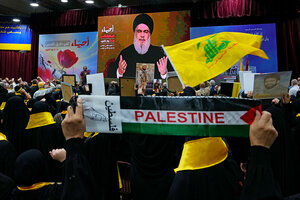Israel’s dilemma in confronting the threat from Hezbollah

An Israeli man assists his father to get into a car so he can be evacuated from Kiryat Shmona, near the border with Lebanon, in northern Israel, Oct. 20, 2023.
Lisi Niesner/Reuters
Tel Aviv, Israel
Kiryat Shmona, in Israel’s far north, is a ghost town. Only a fraction of the city’s 24,000 residents remain, and the sounds of artillery, missiles, and drones fill the air constantly. The siren alerting residents to incoming fire goes off almost at the same instant as the impact, so close is the town to the Lebanese border and Hezbollah militiamen.
As the war in Gaza to the south grinds on in its second month, many Israelis are even more concerned about the rising tensions and daily cross-border exchanges with an old foe to the north – the powerful Iranian-backed Hezbollah militia, which has fired into Israel daily since Hamas’ Oct. 7 cross-border attack from Gaza.
The threat of a devastating regional escalation that could draw in the United States is ever-present; Washington has stationed aircraft carrier groups in the eastern Mediterranean and Persian Gulf, so as to deter Iran and help protect Israel’s northern flank.
Why We Wrote This
Amid its war with Hamas in Gaza, Israel has been loath to open a second front in Lebanon. But fighting has already displaced tens of thousands of Israelis from their homes in the north. Can they return with Hezbollah just over the border?
For now, however, hostilities are still considered to be within defined “parameters” just short of all-out war. But the chances of miscalculation rise with every rocket or anti-tank missile fired by Hezbollah, and every Israeli retaliatory drone or artillery strike.
The Israeli government has evacuated not just Kiryat Shmona but a swath of territory several miles deep along the Lebanese border. Tens of thousands of residents are now internally displaced, like their compatriots in the south, near Gaza. Their future is uncertain, but most are unwilling to return home while Hezbollah and its dangerous Radwan commando force remain just on the other side of the border.
Their message to the Israeli government is clear: Eliminate the threat, even at the risk of a wider conflagration.
“What happened in the south [on Oct. 7] will happen in the north, but just in much greater numbers,” says Doron Shnaper, an aide to Kiryat Shmona’s mayor. “Hezbollah is better armed, better trained, and more capable than Hamas, and they’re sitting 1 meter from Israeli territory.”
Worst fighting since 2006
Northern Israel has known wars and rocket fire for decades. But last month the Israeli government, for the first time, mandated the evacuation of Kiryat Shmona and dozens of other communities in northern Israel due to the threat from Hezbollah. Mr. Shnaper and some 3,000 others have stayed in the city, but the rest of the residents are spread out across Israel, in hundreds of hotels and homes.
The government “told us to prepare for several months,” Mr. Shnaper says.
Much will depend on the duration of the campaign in Gaza, and whether Israel achieves its ambitious goals of eliminating Hamas as a military and governing force in the territory, and recovering some 240 hostages.
Almost immediately after Hamas’ surprise assault, Hezbollah forces, led by their longtime leader Hassan Nasrallah, along with allied Palestinian factions, began attacking Israeli military outposts and communities along the Lebanese frontier with cross-border incursions, anti-tank missiles, rocket and mortar fire, and attack drones. Israel has responded with retaliatory strikes against Hezbollah cells, outposts, and weapons caches.
In the worst bout of fighting between Israel and Hezbollah since their monthlong war in 2006, casualties have mounted on both sides. Eight Israeli soldiers and civilians have been killed, and over a dozen wounded, while Hezbollah has suffered over 70 fatalities.
Prime Minister Benjamin Netanyahu, visiting troops in northern Israel this week, said there were “currently exchanges of severe blows” and that the Israeli military had been ordered to “prepare for any scenario.”
“I suggest that Hezbollah not try the State of Israel; it will be the mistake of its life,” he added.
Israeli officials describe their military’s approach as primarily defensive, responding to Hezbollah attacks but not yet going on the attack. The focus, they insist, is on Gaza – at least for now.
This appears to be largely due to pressure by U.S. President Joe Biden on Israel to avoid widening the conflict beyond Gaza. That silenced talk of an Israeli preemptive strike against Hezbollah, an idea reportedly pushed by Israeli Defense Minister Yoav Gallant and some security chiefs.
Israeli decision-makers are also well aware of the destructive capacity of Hezbollah’s rockets and missiles, which far outstrips that of Hamas and other Gaza-based factions.
The Lebanese militia – now termed a “terror army” by Israeli officials and U.S. analysts – is thought to have over 150,000 projectiles in its arsenal, including long-range precision-guided missiles with heavy warheads that can reach targets anywhere in Israel. Israeli officials warn that if it came to all-out war, Hezbollah could rain thousands of rockets and missiles every day on their towns, military bases, power plants, and other installations.
For comparison, Hamas has fired some 10,000 rockets total into Israel in just over 40 days.
“A wicked problem”
Any real war with Hezbollah would extract “a very, very high price,” says Brig. Gen. Assaf Orion, a retired military officer now with the Institute for National Security Studies in Tel Aviv. “And you’re doing this at a less than ideal time in terms of your own force posture, armaments, and preparations,” since the bulk of Israeli ground forces are focused on Gaza.
In lieu of escalation, Israeli leaders have adopted harsh rhetoric and threats to deter Hezbollah. Mr. Gallant this week urged Hezbollah and all Lebanese citizens to learn from the devastation in Gaza, where more than a million people have been forced from their homes. “What we can do in Gaza, we can also do in Beirut,” he said.
Israeli officials believe that for the time being, Mr. Nasrallah is not seeking a broader conflict, and is content to show solidarity with Hamas and pin down Israeli forces – not least because that would provoke severe Israeli retaliation against his own forces. But “this doesn’t mean there won’t be a mistake – by us or them – and a miscalculation” that could lead to escalation, cautions one Israeli official.
Even if the fighting is contained, as it mostly has been so far, to bands of southern Lebanon and northern Israel, the dilemma for Israeli decision-makers will remain: how to enable the return of their citizens to the villages and towns along the Lebanese border if Hezbollah remains in place.
Many in Israel see this not only as a security challenge, but also as a question of sovereignty and Zionism. If two enemies – Hamas and Hezbollah – can oblige whole communities to move, they will have effectively shrunk Israel’s borders.
This has led many analysts and much of the public to see an end to Hezbollah’s presence in southern Lebanon as essential and inevitable, in light of Hamas’ Oct. 7 attack.
“We’re all ready to pay a price now, to let the army deal with this front with a clear head ... so they solve this issue once and for all,” says Mr. Shnaper, from Kiryat Shmona, speaking for many northern residents waiting to return home.
The authorities may seek to resolve the problem through the permanent deployment of more forces on the border and inside communities themselves, so as to improve security. But the risks, along with the threat, will remain.
“At its core,” says Assaf Orion, the brigadier general, “it’s an unstable situation, and a wicked problem.”


